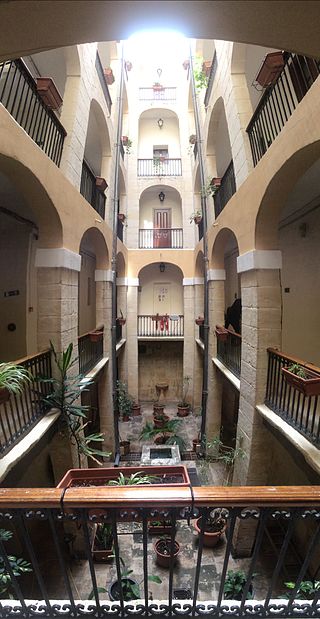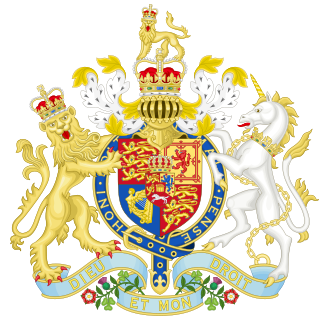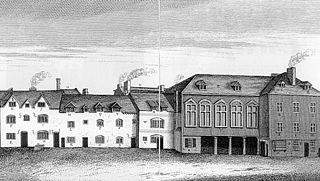A sheriff is a government official, with varying duties, existing in some countries with historical ties to England where the office originated. There is an analogous, although independently developed, office in Iceland, the sýslumaður, which is commonly translated to English as sheriff.

Kilmainham is a south inner suburb of Dublin, Ireland, south of the River Liffey and west of the city centre. It is in the city's Dublin 8 postal district.

A debtors' prison is a prison for people who are unable to pay debt. Until the mid-19th century, debtors' prisons were a common way to deal with unpaid debt in Western Europe. Destitute people who were unable to pay a court-ordered judgment would be incarcerated in these prisons until they had worked off their debt via labour or secured outside funds to pay the balance. The product of their labour went towards both the costs of their incarceration and their accrued debt. Increasing access and lenience throughout the history of bankruptcy law have made prison terms for unaggravated indigence obsolete over most of the world.
A county corporate or corporate county was a type of subnational division used for the administration of justice in certain towns and cities in England, Wales, and Ireland. They arose when the monarch gave a borough corporation the right to appoint its own sheriffs, separating that borough from the jurisdiction of the sheriff of the county in which it lay.

The Gaol Act, sometimes called the Gaol Act 1823, the Gaols Act 1823, the Gaols, etc. (England) Act 1823, the Prison Act 1823, or the Prisons Act 1823, was an act of the Parliament of the United Kingdom to reform prisons. The Gaols Act 1823 mandated i) sex segregated prisons and ii) female warders for female prisoners across the whole of the then British Empire.

The Marshalsea Court was a court associated with the Royal Household in England. Associated with, but distinct from, the Marshalsea Court was the Palace Court, which came into being in the 17th century.
Town commissioners were elected local government bodies that existed in urban areas in Ireland from the 19th century until 2002. Larger towns with commissioners were converted to urban districts by the Local Government (Ireland) Act 1898, with the smaller commissions continuing to exist beyond partition in 1922. The idea was a standardisation of the improvement commissioners established in an ad-hoc manner for particular towns in Britain and Ireland in the eighteenth century. The last town commissioners in Northern Ireland were abolished in 1962. In the Republic of Ireland, the remaining commissions became town councils in 2002, and abolished in 2014.

The Marshalsea (1373–1842) was a notorious prison in Southwark, just south of the River Thames. Although it housed a variety of prisoners—including men accused of crimes at sea and political figures charged with sedition—it became known, in particular, for its incarceration of the poorest of London's debtors. Over half of England's prisoners in the 18th century were in jail because of debt.

Green Street Courthouse is a courthouse between Green Street and Halston Street in the Smithfield area of Dublin, Ireland. It was the site of many widely discussed criminal trials from 1797 until 2010, when the Criminal Courts of Justice building opened.
The Black Dog was a prison in Newhall Market, now Cornmarket, in Dublin, Ireland. Built as a square tower and originally known as Browne's Castle, the site became a tavern and was in use as a prison from at least the 17th century. It was in use up until the late 18th century, when it was replaced by a number of new prisons, including Newgate Prison and a new Sheriff's Prison on Green Street.
The Manor of St. Sepulchre was one of several manors, or liberties, that existed in Dublin, Ireland since the arrival of the Anglo-Normans in the 12th century. They were townlands united to the city, but still preserving their own jurisdiction. St. Sepulchre's was under the jurisdiction of the Archbishop of Dublin, although from time to time the Dublin city government claimed ownership of it.

The Liberty of Thomas Court and Donore was one of several manors, or liberties, that existed in County Dublin, Ireland since the arrival of the Anglo-Normans in the 12th century. They were adjacent to Dublin city, and later entirely surrounded by it, but still preserving their own separate jurisdiction.

The Roman Catholic Relief Act 1793 was an Act of the Parliament of Ireland, implicitly repealing some of the Irish Penal Laws and relieving Roman Catholics of certain political, educational, and economic disabilities.

The Bankruptcy Act 1861 was an Act of the Parliament of the United Kingdom.
The City Marshalsea was a debtor's prison in Dublin, Ireland. Debtors were imprisoned there by order of the Court of Conscience and Lord Mayor's Court of the county of the city of Dublin. The maximum debt was £10 in the Lord Mayor's Court, and 40s. (£2) in the Court of Conscience.
The Dublin City Marshal was an officer of Dublin Corporation in Ireland.

Debtors' Prison Relief Act of 1792 was a United States federal statute enacted into law by the first President of the United States George Washington on May 5, 1792. The Act of Congress established penal regulations and restrictions for persons jailed for property debt, tax evasion, and tax resistance. The indebtedness penalty was governed as a forbidding act for citizens indebted to colonial provinces. The public law granted a sunset provision limiting the term of the federal statute for the colonial domains.

The Tholsel was an important building in Dublin, Ireland which combined the function of civic hall, guildhall, court, gaol and even for a period acted as parliament house from 1641-48.













